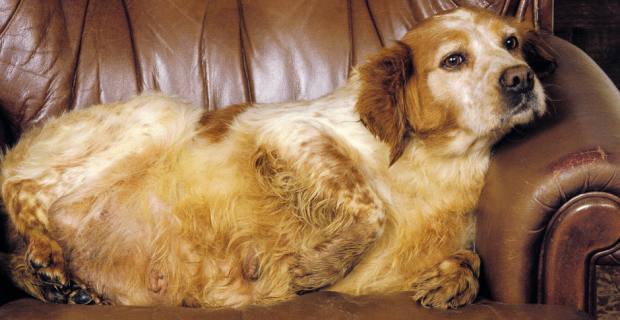A obesidade é uma doença endócrino-metabólica de incidência e de prevalência crescentes entre humanos e animais de companhia. Os gastos em saúde pública ocasionados pelas consequências da epidemia de obesidade em seres humanos, anualmente, têm acompanhado essa tendência de crescimento. Contudo, nem todos os aumentos que temos visto se tratando de obesidade são negativos.
Em Medicina Veterinária, por exemplos, houve um aumento exponencial do conhecimento sobre consequências do sobrepeso na saúde de cães e gatos, permitindo que o conceito de obesidade como uma doença venha tendo uma aplicação crescente em nossa profissão. Sendo os médicos-veterinários profissionais de saúde preocupados com a saúde de cães e gatos, é dever da classe compreender a obesidade como um problema de saúde e tomar ações para sua prevenção e controle. Para isso, é fundamental a compreensão do papel do tecido adiposo como uma glândula endócrina.
A castração é uma antiga vilã que costuma ser apontada na patogenia da obesidade, contudo apesar de ausência de consenso na literatura sobre a gonadectomia promover redução da taxa metabólica, sabemos que a castração pode induzir um aumento no apetite, bem como um maior sedentarismo e, com isso, criar-se um cenário favorável ao balanço energético positivo.
O Artigo completo foi dividido em três partes: “Como surge a obesidade?” (edição 253 – Setembro), “Doenças endócrinas e obesidade” (edição 254 – Outubro) e “Síndrome metabólica” (edição 255 – Novembro), para lê-lo basta acessar revistacaesegatos.com.br
Abaixo as referências utilizadas pelo autor:
Abella V, Scotece M, Conde J, Pino J, Gonzalez-Gay MA, Gómez-Reino JJ, Mera A, Lago F, Gómez R, Gualillo O. Leptin in the interplay of inflammation, metabolism and immune system disorders. Nat Rev Rheumatol. 2017 Feb;13(2):100-109.
Azamar-Llamas D, Hernández-Molina G, Ramos-Ávalos B, Furuzawa-Carballeda J. Adipokine Contribution to the Pathogenesis of Osteoarthritis. Mediators Inflamm. 2017; 2017: 5468023.
Bray GA, Heisel WE, Afshin A, Jensen MD, Dietz WH, Long M, Kushner RF, Daniels SR, Wadden TA, Tsai AG, Hu FB, Jakicic JM, Ryan DH, Wolfe BM, Inge TH. The Science of obesity management: An endocrine society scientific statement. Endocrine Reviews. v.39(1): 1-54, 2018.
Costa JV, Duarte JS. Tecido adiposo e adipocinas. Acta Médica Portuguesa. v. 19: 251-256, 2006.
Day MJ. One health approach to preventing obesity in people and their pets. Journal of Comparative Pathology. v.156: 293-295, 2017.
Diez M, Nguyen P. The epidemiology of canine and feline obesity. Waltham Focus. v.16(1): 2-8, 2006.
Fonseca-Alaniz MH, Takada J, Alonso-Vale MI, Lima FB. O tecido adiposo como centro regulador do metabolismo. Arquivos Brasileiros de Endocrinologia e Metabolismo. v.50(2): 216-229, 2006.
Frye CW, Shmalberg JW, Wakshlag JJ. Obesity, Exercise and Orthopedic Disease. Vet Clin North Am Small Anim Pract. 2016 Sep;46(5):831-41.
German AJ, Hervera M, Hunter L, Holden SL, Morris PJ, Biourge V, et al. Improvement in insulin resistance and reduction in plasma inflammatory adipokines after weigth loss in obese dogs. Dom An Endocri 2000; 37: 214-26.
German AJ. Clinical risks associated with obesity in companion animals. Walthan Focus. v.16(1): 21-26, 2006.
German AJ. The growing problem of obesity in dogs and cats. Journal of Nutrition. 136: 1940S–1946S, 2006.
German AJ. Weight management in obese pets: the tailoring concept and how it can improve results. Acta Veterinaria Scandinavica. v.58(suppl1):57, 2016.
Heuberger R., Wakshlag J. The relationship of feeding patterns and obesity in dogs. Journal of Animal Physiology and Animal Nutrition. 95: 98–105, 2011.
Ishioka K, Omachi A, Sagawa M, Shibata H, Honjoh T, Kimura K, Saito M. Canine adiponectin: cDNA structure, mRNA expression in adipose tissues and reduced plasma levels in obesity. Research in Veterinary Science. v. 80(2): 127-132, 2006.
Ishioka K, Soliman MM, Sagawa M, Nakamodo F, Shibata H, Honjoh T, Hashimoto A, Kitamura H, Kimura K, Saito M. Experimental and clinical studies on plasma leptin in obese dogs. Journal of Veterinary Medicine and Science. v. 64(4): 349-353, 2002.
Jericó MM, Andrade Neto JP, Kogika MM. Tratado de Medicina Interna de Cães e Gatos. v.2. Roca, 2015.
Kieffer TJ, Habener JF. The adipoinsulinar axis: effects of leptin on pancreatic beta cells. American Journal of Physiology Endocrinology and Metabolism. v.278: E1-E14, 2000.
Kil DY, Swanson KS. Endocrinology of obesity. Vet Clin Small Anim 2010; 40: 205–219.
Kipperman BS, German AJ. The responsibility of veterinarians to address companion animal obesity. Animals. v.8, 143. 2018.
Kim AY, Kim HS, Kang JH, Yang MP. Serum adipokine concentrations in dogs with diabetes mellitus: A pilot study. Journal of Veterinary Science. v.16(3): 333-340, 2015.
Kuryszko J, Slawuta P, Sapikowski G. Secretory function of adipose tissue. Polish Journal of Veterinary Sciences. v.19(2): 441-446, 2016.
Lawler DF, Evans RH, Larson BT, Spitznagel EL, Ellersieck MR, Kealy RD. Influence of lifetime food restriction on causes, time, and predictors of death in dogs. J Am Vet Med Assoc. 2005;226: 225–31.
Lee S, Kweon O, Kim WH. Associations between serum leptin levels, hyperlipidemia, and cholelithiasis in dogs. PLoS ONE. v. 12(10): e0187315, 2017.
Lee S, Kweon O, Kim WH. Increased leptin and leptin receptor expression in dogs with gallbladder mucocele. Journal of Veterinary Internal Medicine. v.31: 36-42, 2017.
Lund EM, Armstrong PJ, Kirk CA, Klausner JS. Prevalence and risk factors for obesity in adult dogs from private US veterinary practices. International Journal of Applied Research in Veterinary Medicine. v.4(2): 177-186, 2006.
Machado L, Hechter L, Santos FMM, Eugênio DA, Martins SFM, Carvalho GCG, Pöppl AG. Prevalência de sobrepeso/obesidade em pequenos animais atendidos no Hospital de Clínicas da UFRGS. In: Anais 3° CIABEV, Guarujá, São Paulo. Clínica Veterinária v.131 (Suppl):58, 2017.
Martin LJM, Siliart B, Dumon HJW, Nguyen PG. Hormonal disturbances associated with obesity. Journal of Animal Phisiology and Animal Nutrition. v.90: 355-360, 2006.
Mazaki-Tivi M, Abood SK, Segev G, Schenck PA. Alterations in adipokines in feline hepatic lipidosis. Journal of Veterinary Internal Medicine. v.27: 242-249, 2013.
Moller DE, Kaufman KD. Metabolic syndrome: a clinical and molecular perspective. Annual Review Medicine. v.56:45-62, 2005.
Nishii N, Nodake H, Takasu M, Soe O, Ohba Y, Maeda S, Ohtsuka Y, Honjo T, Saito M, Kitagawa H. Postprandial changes in leptin concentration of cerebrospinal fluid in dogs during developement of obesity. American Journal of Veterinary Research. v. 67(12): 206-2011, 2006.
Philp AM, Collier RL, Grover LM, Davis ET, Jones SW. Resistin promotes the abnormal Type I collagen phenotype of subchondral bone in obese patients with end stage hip osteoarthritis. Sci Rep. 2017 Jun 22;7(1):4042.
Pöppl A G. Obesidade em Cães e Gatos. In: Andrigo Barboza De Nardi; Marcello Rodrigues da Roza. (Org.). Associação Nacional de Clínicos Veterinários de Pequenos Animais PROMEVET Pequenos Animais: Programa de Atualização em Medicina Veterinária. 1ed. Porto Alegre: Artmed Panamericana, 2018, v. C3V4, p. 111-168.
Radin MJ, Sharkey LC, Holycross BJ. Adipokines: a review of biological and analytical principles and an update in dogs, cats, and horses. Veterinary Clinical Pathology. Apr 6, 2009 [Epub ahead of print].
Raffan E, Dennis RJ, O´Donovan CJ, Becker JM, Scott RA, Smith SP, et al. A deletion in the canine POMC gene is associated with weigtht and apetite in obesity-prone labrador retriever dogs. Cell Metabolism. v. 23: 1-8, 2016.
Ryan VH, Trayhurn P, Hunter L, Morris PJ, German AJ. 11-hydroxy-β-steroid dehydrogenase gene expression in canine adipose tissue and adipocytes: Stimulatioon by lipopolysaccharide and tumor necrosis factor α. Domestic Animal Endocrinology. v.41: 150-161, 2011.
Sagawa MM, Nakamodo F, Honjoh T, Ishioka K, Saito M. Correlation between plasma leptin concentration and body fat content in dogs. American Journal of Veterinary Research. v. 63(1):7-10, 2002.
Salt C, Morris PJ, Wilson D, Lund EM, German AJ. Association between life span and body condition in neutered client-owned dogs. Journal of Veterinary Internal Medicine. v. 33:89-99, 2019.
Sonnenschein EG, Glickman LT, Goldschmidt MH, Mckee LJ. Body conformation, diet, and risk of breast cancer in pet dogs: a case-control study. American Journal of Epidemiology, v.133(7): 694-703, 1991.
Tilg H, Moschen AR. Adipocytokines: mediators linking adipose tissue, inflammation and immunity. Nature Reviews Immunology. v.6(10): 772-783, 2006.
Tvarijonaviciute A, Ceron JJ, Holden SL, Cuthbertson DJ, Biourge V, Morris PJ, German AJ. Obesity-related metabolic dysfuntion in dogs: a comparison with human metabolic syndrome. BMC Veterinary Research. v.8:147, 2012.
Tvarijonaviciute A, Ceron JJ, Torre C, Ljubic BB, Holden SL, Queau Y, Morris PJ, Pastor J, German AJ. Obese dogs with and without obesity-related metabolic dysfunction – a proteomic approach. BMC Veterinary Research. v.12: 211, 2016.
Verkest KR, Fleeman LM, Morton JM, Ishioka K, Rand JS. Compensation for obesity induced insulin resistance in dogs: assessment of the effects of leptin, adiponectin and glucagon-like peptide-1 using path analysis. Domestic Animal Endocrinology 41, 24-34, 2011.
Verkest KR, Rand JS, Fleeman LM, Morton JM, Richards AA, Rose FJ, Whitehead JP. Distinct adiponectin profiles might contribute to differences in susceptibility to type 2 diabetes in dogs and humans. Domestic Animal Endocrinology 41: 67-73, 2011.
Verkest KR, Rand JS, Fleeman LM, Morton JM. Spontaneously obese dogs exhibit greater postprandial glucose, triglyceride, and insulin concentration than lean dogs. Domestic Animal Endocrinology 42, 103-112, 2012.
Verkest KR. Is the metabolic syndrome a usefull clinical concept in dogs? A review of the evidence. The Veterinary Journal. v.199: 24-30, 2014.
Wakshlag JJ, Struble AM, Levine CB, Bushey JJ, Laflamme DP, Long GM. The effects of weight loss on adipokines and markers of inflammation in dogs. British Journal of Nutrition. v.106:S11-S14, 2011.
Zoran DL. Obesity in dogs and cats: a metabolic and endocrine disorder. Veterinary Clinics Small Animal. v.40: 221-239, 2010.









